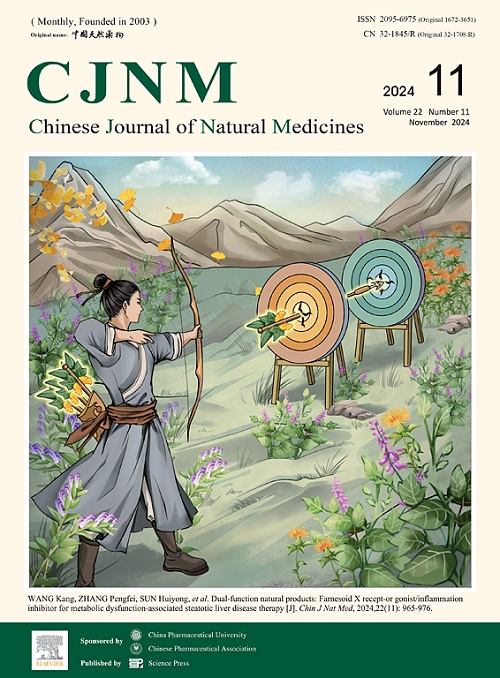Lirispirolides A−L:一类新的具有抗神经炎症活性的倍半萜-单萜异二聚体
IF 4.9
2区 医学
Q1 INTEGRATIVE & COMPLEMENTARY MEDICINE
引用次数: 0
摘要
Lirispirolides A−L(1−12)是从中国珍稀药用观赏植物Liriodendron chinense [Liriodendron chinense (L. chinense)]的枝叶中分离到的12个具有独特碳骨架的倍半萜-单萜异二聚体。通过全面的光谱分析、量子化学计算和x射线晶体学完成了结构解析。这些异源二聚体表现出典型的2-oxaspiro[4.5]decan-1- 1结构基序,是通过分子间[4 + 2]环加成形成的,在一个德国烷型倍半萜和一个八烯型单萜之间形成。大多数分离的化合物通过减少促炎介质,特别是肿瘤坏死因子-α (TNF-α)和一氧化氮(NO)的产生,在脂多糖(LPS)诱导的BV-2小胶质细胞中显示出显著的抗神经炎症作用。进一步研究发现,利利匹罗内酯类药物对NO释放的抑制作用与诱导NO合成酶(iNOS)信使核糖核酸(mRNA)表达的降低有关。本文章由计算机程序翻译,如有差异,请以英文原文为准。
Lirispirolides A−L, a new class of sesquiterpene-monoterpene heterodimers with anti-neuroinflammatory activity from the rare medicinal plant Liriodendron chinense
Lirispirolides A−L (1−12), twelve novel sesquiterpene-monoterpene heterodimers featuring distinctive carbon skeletons, were isolated from the branches and leaves of Chinese tulip tree [Liriodendron chinense (L. chinense)], a rare medicinal and ornamental plant endemic to China. The structural elucidation was accomplished through comprehensive spectroscopic analyses, quantum-chemical calculations, and X-ray crystallography. These heterodimers exhibit a characteristic 2-oxaspiro[4.5]decan-1-one structural motif, biosynthetically formed through intermolecular [4 + 2]-cycloaddition between a germacrane-type sesquiterpene and an ocimene-type monoterpene. The majority of the isolated compounds demonstrated significant anti-neuroinflammatory effects in lipopolysaccharide (LPS)-induced BV-2 microglial cells by reducing the production of pro-inflammatory mediators, specifically tumor necrosis factor-α (TNF-α) and nitric oxide (NO). Further investigation revealed that the lirispirolides’ inhibition of NO release correlated with decreased messenger ribonucleic acid (mRNA) expression of inducible NO synthase (iNOS).
求助全文
通过发布文献求助,成功后即可免费获取论文全文。
去求助
来源期刊

Chinese Journal of Natural Medicines
INTEGRATIVE & COMPLEMENTARY MEDICINE-PHARMACOLOGY & PHARMACY
CiteScore
7.50
自引率
4.30%
发文量
2235
期刊介绍:
The Chinese Journal of Natural Medicines (CJNM), founded and sponsored in May 2003 by China Pharmaceutical University and the Chinese Pharmaceutical Association, is devoted to communication among pharmaceutical and medical scientists interested in the advancement of Traditional Chinese Medicines (TCM). CJNM publishes articles relating to a broad spectrum of bioactive natural products, leading compounds and medicines derived from Traditional Chinese Medicines (TCM).
Topics covered by the journal are: Resources of Traditional Chinese Medicines; Interaction and complexity of prescription; Natural Products Chemistry (including structure modification, semi-and total synthesis, bio-transformation); Pharmacology of natural products and prescription (including pharmacokinetics and toxicology); Pharmaceutics and Analytical Methods of natural products.
 求助内容:
求助内容: 应助结果提醒方式:
应助结果提醒方式:


